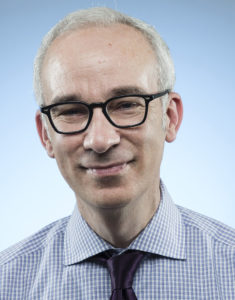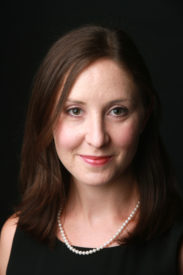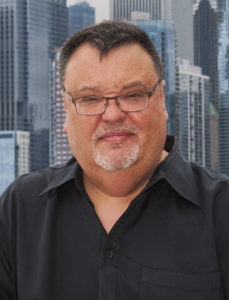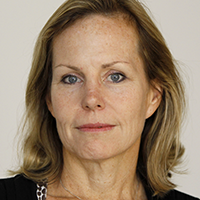Journalists who break stories about powerful men who have sexually harassed or otherwise abused women face a host of challenges. These include getting women to go on the record and facing down threats from lawyers. Yet as difficult as such stories can be to nail down, journalists who have done so are well aware of the reporting that needs to be done on systems in place that enable harassers and silence victims.
“This is much bigger than a few bad apples like Roger Ailes and Harvey Weinstein. This is a systemic problem.”
Gabriel Sherman

Special correspondent, Vanity Fair
Sherman for years had a laser focus on covering the late Fox News chairman and CEO Roger Ailes, the subject of his 2014 biography. For New York magazine, Sherman wrote extensively about sexual harassment allegations against Ailes, who was forced to resign from the company last year. He denied the allegations.
We’re at a cultural moment when the culture is ready to listen to victims and take the allegations seriously. Unfortunately, a lot of these stories, if you look back, starting with Bill Cosby, had been floating out there in the public domain and had been dismissed. It took the snowball effect of the Roger Ailes story, Bill Cosby’s story to create this cultural moment when the public was ready to open their eyes and see the depth of this problem.
Going back, I had several examples in my book [“The Loudest Voices in the Room: How the Brilliant, Bombastic Roger Ailes Built Fox News—and Divided a Country”] of on‑the‑record allegations. Unfortunately, those were lightly covered at the time. That was partly maybe reflective of major news organizations weren’t willing to dive in and investigate these allegations against powerful men. After [former Fox news anchor] Gretchen Carlson filed her lawsuit [in 2016], that was a public document. That pushed the Ailes sexual harassment story into the public domain so that it created a context for me to do further reporting and perhaps have women’s allegations taken more seriously by the public.
Within of days of her lawsuit, I heard from a half dozen women, two of whom I believe spoke on the record about incidents of Ailes’ harassment. Those stories exploded on social media and were picked up by other news outlets. I continued to hear from more women. The floodgates were open, and I was hearing from more and more of Ailes’s victims. That willingness to come forward was very different than when my book came out in 2014. I was expecting there to perhaps be more people coming forward, and it didn’t materialize.
To me, the story really is about the system of enablers that powerful men set up to protect this abhorrent behavior, and also silence women from speaking out. To me, there’s still a lot of reporting to be done about the way corporate America enforces nondisclosure agreements and uses legal and HR departments to cover up sexual harassment in the workplace. This is much bigger than a few bad apples like Roger Ailes and Harvey Weinstein. This is a systemic problem.
I think back to the way The Boston Globe covered the Catholic Church abuse scandal. They really focused on the system that protected priests who had abused children. In many ways, this is similar. There is a corporate system in place, enforced through contracts and legal means, that has kept this epidemic of harassment hidden from the public.
What will change, whether through legislation or shifting cultural norms: The enforcement of NDAs and secrecy around harassment will no longer be tolerated in workplaces, this open secret of people knowing about abusive behavior not being tolerated. What changes will be the willingness of not only women coming forward, but bystanders coming forward to speak up about a behavior they see that’s either inappropriate or abusive.
Journalism is a mirror of the society in which it functions. The fact that this issue is now getting the public attention it deserves is reflective of the increased power of women in the workplace. The mobilization we saw after the election of Donald Trump, where women felt emboldened and motivated to speak up when we had a president who was elected after being revealed to be bragging about sexual assault on the “Access Hollywood” tape.
Also, we can’t discount the role that social media has played in breaking down this culture of secrecy. The whole #MeToo campaign, the different Twitter hashtag movements we’ve seen spring up around stories of sexual assault and abuse in the workplace, this has all created the kind of context that journalism needs to expose large‑scale abuses. I hope this moment doesn’t pass because there’s still, unfortunately, a lot more work to be done.
“Especially for women, and really across the board, people who have been bullied and harassed … want this to be a transformational moment.”
Kim Masters
Editor at large, The Hollywood Reporter

Over the summer The Hollywood Reporter, Masters’ employer, declined to publish a story she wrote about unwelcome sexual comments producer Isa Hackett said Roy Price, the head of Amazon Studios, made to her. The Information published it in August. In the wake of the Harvey Weinstein scandal in October, Masters wrote a follow-up story for The Hollywood Reporter. Within hours, Amazon suspended Price from his job. He has since resigned.
We’re in a peculiar environment where there are lists going around of alleged harassers, and it’s pretty dangerous to do that. That’s not journalism, so I would think any company that has an allegation of sexual harassment would take a look before it becomes a gigantic public debacle.
I am seeing a little bit of a pattern beginning to emerge. Where there’s potentially questionable conduct, the executive lawyers up, always with his own lawyer. I think it’s because in some cases—I felt this in Amazon’s case—they just were not willing to attack the way Roy Price’s personal lawyer did. Also, I think it’s because if he goes to the corporate counsel and actually tells them everything that may have happened, that might not be such a good option for him.
I think we’re going to see these guys lawyering up personally because their companies won’t defend them, or they don’t want to really be completely candid with their in‑house counsel. I think we’ll see this attempt to name reporters as individuals to try and make it scarier. It’s, I guess, supposed to be a scare tactic. But I think you have to be a very naive reporter not to ask for indemnification if you’re a freelancer, or you don’t have a company that’s backing you.
Especially for women, and really across the board, people who have been bullied and harassed, they just don’t want this to be a transitory moment. They want this to be a transformational moment, so they’re keeping the discussion going.
What I have come to recognize more than ever before is how women are excluded because guys are maintaining this culture. They find that they can’t have their fun, and I’m not talking about sexual assault necessarily but a frat house atmosphere, trips to Vegas, strip clubs, prostitutes. They feel they can’t have the uninhibited good times if there is a woman present, so that’s part of the reason women are excluded. That is something that we need to put a stop to if women are going to be treated properly in the workplace, both professionally, and in terms of harassment.
“There shouldn’t be fatigue, because each time these stories come out, it’s really a big deal for the person who reports it.”
Glenn Whipp
Entertainment reporter, LA Times

Following the downfall of Harvey Weinstein and the rise of #MeToo, Whipp got a tip about filmmaker James Toback. Once his story about Toback’s alleged serial sexual harassment was published, Whipp soon heard from 200 additional women who wanted to talk about their encounters with Toback, who has denied the allegations.
The first story I wrote had 38 women, 31 on the record, talking about Toback, and that’s a large number. I think that speaks to women finding the courage in the wake of what happened to Harvey Weinstein to come forward and share their experiences.
There was the hashtag campaign on Twitter, #MeToo, where women were identifying themselves on Twitter as victims of a spectrum of sexual misconduct. At that time, I plugged Toback’s name into the Twitter search engine, and there were five or six women who had used his name in connection with the #MeToo. I contacted as many as I could who had done this. One of them was Louise Post, who’s a singer‑guitarist for the band Veruca Salt. She was in the story. I’ve received emails back from some of these other women. I talked to Selma Blair around noon that day, and then it kept snowballing from there.
I know a lot of very good people in the motion picture industry that are working toward change, but we’ve seen these moments before, too. If somebody asks, “Will things change? It’s a watershed moment.” You’d like to think so, but then again, we’ve been here before, and we think we’re on the cusp of change, and it doesn’t. It goes back to the same old, same old. I will say that I feel like news organizations like the LA Times, The New York Times are working toward covering this and writing about it in a way that, hopefully, does enact some change.
As for fatigue, it’s like you’ve become somewhat deadened to another story about this topic, but each story is a new story, and it’s with new victims who have been keeping these stories inside for decades. I have to treat them like it was the first woman I talked to, my first source on the story, because for so many of these women, they probably told someone at the time it happened, and then they just kept it inside for years.
There shouldn’t be fatigue, because each time these stories come out, it’s really a big deal for the person who reports it. It’s still so hard for people to come forward and share their stories, and that won’t ever stop. I don’t think it will ever be easier just because we’ve had several figures now come out and say these things. It’s never going to be easy for a woman or a man to come out and say these types of things, because the stories are so personal, and there’s a lot of guilt and shame wrapped up in coming forward and talking about it. That was always my thing with this, making sure that I honored these women’s stories. That was the most important thing always for me in reporting the piece.
“The story that we published has triggered a conversation in our community about sexual harassment in the restaurant industry.”
Brett Anderson
Restaurant critic and features writer, The Times-Picayune in New Orleans
His investigation into sex harassment at renowned chef John Besh’s restaurants started in February when he received a tip: Lindsey Reynolds, who worked at the corporate office of the Besh Restaurant Group (BRG), alleged in her resignation letter that there was a culture of harassment. Anderson’s investigation, with allegations by 25 current and former BRG employees including nine who were identified by name, was published in October, just as the Harvey Weinstein story broke. Besh, who denied the allegations but admitted to certain “moral failings,” stepped down days later.
When I originally did my reporting, I granted anonymity to everyone I was talking to. I wasn’t going to get people to speak to me freely about what they knew and what they experienced without that.
I just began calling people. Most of the sources were like, one source would lead to another source. Every time I would speak with someone, I’d say, “You know, is there someone you think that had experiences like this that would be willing to speak with me?” Lindsey Reynolds and a woman named Madie Robison were early to go on the record. When I started to ask other people whether or not they would consider sharing with me, letting me print their name with the allegations, I think it helped that they were with a couple of others. Over time, the question would go from, “You would be the third named source in the story” to “You would be the fourth named source” or “You would be the fifth named source…”
The first two to go on the record were women I had been speaking to a lot. I’d had a lot of conversations with those sources over the months before they decided to go on the record. I think by the time they decided, they were comfortable with the fact that I had a lot of other information and that it wasn’t going to be just a story entirely hanging around their necks. My other sources understood that as well. I tried to tell them, it wasn’t going to be all on them, and that what I was writing about was what my reporting suggested was a pattern of behavior at the company.
The thing is about restaurants, they were widely known and accepted among people in the industry, and even people who cover the industry, that the workplaces could be coarse. I would remind myself and remind even my sources about how they had basically come to expect a certain type of treatment working at restaurants, and say, “You know, people who work in restaurants have all the same legal protections as people working everywhere else.” In some way, that’s not a fact that’s accepted or perhaps even known among a lot of people. The restaurant owners and bar owners are supposed to create an environment where the employees are free of harassment from each other, but also, from customers.
Every woman I spoke to who had worked at restaurants prior to coming to the John Besh Restaurant Group would invariably tell me that they had experienced harassment in other jobs at restaurants not owned by John. Every single person I interviewed who had worked at places before John’s restaurant, I asked, “Was what you experienced at the Besh Restaurant Group different than what you experienced elsewhere?” Every single one, except for one or two, said that it was a degree worse at Besh. That was a motivating factor in some of these women deciding to go on the record, I believe, where they felt that even though they understood and accepted that the restaurant business required you to have a high tolerance for certain coarse language and perhaps worse, they all believed that what they experienced at BRG was a degree worse than that.
The story that we published has triggered a conversation in our community about sexual harassment in the restaurant industry. Whether or not that’s going to result in change, I have no idea, but I think it would be a missed opportunity if it didn’t.
I think that the news‑consuming public had read enough about harassment elsewhere that they were ready to be outraged by what my story unearthed. I also think there’s a lot more waiters and waitresses out there than there are former Hollywood actors and former “Fox News” stars, which isn’t to take anything away from what those people have experienced. But I do think that one of the reasons people probably read my story and got to the end of it is that there’s just a lot more former restaurant workers out there that are able to really empathize with what these people were saying.
“Women certainly have found their voice to talk about these issues.”
Emily Steel
Business reporter, The New York Times

Marquee Fox News host Bill O’Reilly was fired in April and there was an exodus of advertisers following a story by Steel and Michael S. Schmidt that about $13 million had been paid to address complaints about O’Reilly’s treatment of women. Six months later, the two Times reporters published another bombshell report, that O’Reilly—who continues to dismiss the allegations—was said to have agreed to a $32 million settlement of a sex harassment allegation by a former Fox analyst.
When we were doing our reporting on the Bill O’Reilly story, we started by looking at that 2004 dispute: This young woman, this young producer, Andrea Mackris, who worked for O’Reilly’s show, filed a suit against Bill O’Reilly that included a number of salacious allegations. In the course of our reporting, we went back and looked at coverage of that case in 2004. The initial round of stories covered the allegations in the suit.
Then in the weeks before that case was settled, what our reporting found is that the Fox News-O’Reilly camp really fed this next wave of stories, and they used a private investigator and a public relations campaign to dig up information about the woman. They fed that information to the tabloids, and it was really this attempt to depict her as a promiscuous woman who was deeply in debt and who was trying to shake O’Reilly down.
I think that a lot has changed since 2004, and our culture listens to these allegations in a different way. There isn’t necessarily as much victim shaming or slut shaming when people make these allegations.
There’s a lot of forces at play about why we’re seeing all these stories now, and why news organizations are maybe thinking about them or writing about them differently. To understand that, you really do have to go back to how these issues were covered before, and what might change when there’s more women in newsrooms or when there are young women who are assigned to do these stories. Maybe they’re taken seriously in a way that they might not have been before. Women certainly have found their voice to talk about these issues.
A lot of the reporting has been about allegations against one person, but I think to really understand the forces at play here you have to think a lot about power dynamics in this system that have allowed this to perpetuate. What does this mean for human resources departments? What does this mean for reporting lines? What does this mean about the law?
“The biggest drug in our culture is celebrity”
Jim DeRogatis
Music journalist

In 2000, after he reviewed R. Kelly’s new album for the Chicago Sun-Times, DeRogatis received a tip that Kelly was having sex with underage girls. Over the years, DeRogatis has continued to investigate the musician. This summer BuzzFeed published DeRogatis’s exposé alleging that Kelly is keeping six women in a sex “cult.” Kelly has dismissed the allegations.
Now, we have the floodgates opened, but for how long, and to what extent does it change anything? It’s hard to be optimistic when we have a president of the United States of America who said, “Grab them by the pussy,” and apparently meant it and did it.
The biggest drug in our culture is celebrity. That’s why we have the president we have. I know of many other stories that are similar of predators, of people who were abusing women, that aren’t being told because they’re absent celebrity. Either the predator’s not a celebrity or the women, the victims, aren’t celebrities, or both. What we’re seeing in #metoo and all the press coverage is famous people got hurt, so we care.
This is a cultural problem. It’s part of rape culture. It’s part of law enforcement not doing what it should do for anyone who is in peril. How many of those stories would be running if the victims weren’t famous and the perpetrator wasn’t famous? I don’t think many of them at all, because for every one we’re reading, hundreds or thousands aren’t being reported.
There are centuries of great artists who have been fairly despicable human beings. It’s a laudable notion: Let us separate the art from the despicable human being. There are cases where that can’t be done. That’s when the art is a reflection of the artist’s misdeeds.
I don’t see how art, the art we consume, should get any less thought than the way we operate in life in general as ethical, thinking people. I think art can inspire us to change the world, and I think art in very rare circumstances can be used to do considerable evil. Criticism is a conversation between people who care passionately about the art. The critic is not somebody who sits on the mountaintop and dictates her opinions to the rest of you plebs who don’t understand, don’t know better. No, it comes alive when we talk about this art.
I think everybody is a critic, or everybody should be. To live life to the fullest, think about the art that you’re consuming. I use that word because it’s the same as the cheeseburger. You’re putting it in your body. Thinking about the art you’re putting in your body. You’re sitting there watching “House of Cards” or listening to R. Kelly, or seeing the Gauguin exhibit. I think everybody should not only be a critic, but an investigative critic, in the sense that we owe it to ourselves to investigate the meaning of and the context for this art.
“It can’t be 30 or 40 women’s fault.”
Michelle Cottle
Contributing editor, The Atlantic

When Cottle worked at The New Republic for 12 years beginning when she was 28, she was subjected to what she calls literary editor Leon Wieseltier’s “low-level lechery.” In late October, following the firing of Harvey Weinstein and in the wake of complaints about Wieseltier’s “past inappropriate workplace conduct,” the funder of a new magazine Wieseltier was to edit pulled the plug on the project. In an Atlantic piece called “Leon Wieseltier: A Reckoning,” Cottle writes about the literary editor’s behavior toward her and her female colleagues at TNR.
The group of women who had been thinking of talking to The New York Times but that got mishandled in some way so they wound up seeing if I would handle the story. They didn’t all want to go out on their own and do individual stories. There was a safety in numbers sense to it, so they needed somebody to provide the framework.
My part was easy enough to do. The women did the heavy lifting. You had so many people willing to go on the record, which, if you’ll notice, even when these things are breaking, it’s a hard thing for people to put their names to. It just kind of happened that they all felt comfortable going together. The Atlantic did a lot of hand‑holding and were really good about providing the opportunity for that.
Because part of my piece is devoted to almost a template of how this works sometimes, of how certain kinds of inappropriate behavior, especially the non‑Harvey Weinstein kind, where it’s a little more subtle and a little more complicated, it was actually kind of useful. For every experience one person had, it fit into a category that 10 other people had had. I know it sounds really weird, but there were inappropriate categories like the touching, the talk about sex, or the teasing about your sex life.
Then of course, everybody felt self‑blame, guilt, and complicity, and that was the most disheartening part of it, that even once people understood the scope of what had happened, they still felt like, “Oh, well it must be my fault in some way,” or, “I should have done something differently.”
That was really important to spotlight, that everybody felt this way. That just can’t be. It can’t be 30 or 40 women’s fault. That’s not a reasonable interpretation of the situation.
The other kind of self‑blame was, even if I was handling it or had figured out how best that I wanted to handle it, none of us were really thinking in terms of younger staffers or more junior staffers. So a lot of people wound up feeling, “Oh my gosh, I should have been thinking in terms of what was going on more broadly.” You can feel bad that you didn’t think in terms of other people even as you’re trying to deal with it yourself, but under no circumstances should you be like, “Oh, well, this is my fault. I was asking for it. I brought it on myself.”
I’ve heard from every man I ever worked with at TNR. They’ve all been writing and tweeting, and I’ve gotten calls from them asking what they should have done or should be doing now. What should they have seen?
The question of what they should have seen is one that I obviously can’t answer. The question of what they could have done is also pretty tricky. There’s only so much you can do when the man who has the power to deal with this has decided not to. I don’t think anybody understood the full extent of it, so it’s not like the guys were standing around watching all of this every day. There were different degrees and different levels. It’s really hard to say what could have been done or should have been done. That’s why people feel guilty now, because they’re like, “Oh, well, even if it was weird or delicate, I should have just said, ‘Enough’ and put on my big girl pants and done what needed to be done.”
Every time somebody gets taken seriously and every time the signal is sent that this is not the way it’s supposed to be, it makes it easier for the next woman to come forward and say, “Well, OK, you did it, and you survived it. I can do this.”
“More people were acknowledging a history of sexual abuse, making the allegations in high-profile cases perhaps more plausible.”
Maryclaire Dale
Reporter, The Associated Press

As an Associated Press reporter in Philadelphia, 2018 Nieman Fellow Maryclaire Dale covered a 2005 police complaint against actor Bill Cosby that prosecutors declined to pursue, citing insufficient evidence of sexual assault. Accuser Andrea Constand instead sued Cosby, and he agreed to a confidential settlement a year later after giving deposition testimony. When a new round of accusations surfaced in 2014, Cosby’s camp again denied the women’s claims. The AP petitioned to unseal documents from the 2005 lawsuit, unearthing Cosby’s testimony and leading a new prosecutor to arrest him in Constand’s case. A jury deadlocked on the charges this year, and a retrial is set for April.
When comedian Hannibal Buress called Bill Cosby a rapist in a 2014 stand-up act, more women came forward to accuse “America’s dad” of sexual assault. Cosby’s camp again dismissed the claims.
The “he said, she said” stalemate frustrated me. Cosby was not just a TV and comedy legend, he was an institution in his native Philadelphia, where I worked for The Associated Press. I knew of only one time he had been forced to respond to the allegations under oath—but the deposition, from an accuser’s 2005 lawsuit, remained sealed after Cosby settled the case in 2006.
The AP had tried to have the case filings unsealed at the time, to no avail. We wondered whether to try again. The conversation around sexual assault had changed in the decade since.
More people were acknowledging a history of sexual abuse, making the allegations in high-profile cases perhaps more plausible. More accusers were willing to be named in public, enhancing the transparency of their claims. Documents unearthed in the Roman Catholic Church, Penn State, and other cases revealed the astonishing breadth of the problem. And the public was starting to question enablers—lawyers, handlers, church and university officials—who had helped keep abuse complaints hidden.
In late 2014, the AP petitioned the Cosby judge to unseal the decade-old filings in accuser Andrea Constand’s case. Cosby’s lawyers fought back. They said the deposition excerpts would “embarrass” the aging actor, prompting U.S. District Judge Eduardo Robreno to ask why Cosby would be embarrassed by “his own version of the facts.” Weeks later, Robreno unsealed documents that showed Cosby had repeatedly gotten quaaludes in the 1970s to give women before sex and had, over several decades, given a string of young women pills and alcohol before sexual encounters that he deemed consensual.
Cosby’s testimony cut through the hazy cloud of accusations that threatened his 50-year career and legacy. A prosecutor filed criminal sex assault charges in Constand’s case, leading to a trial that ended with a hung jury in June. In the months since, media investigations have brought down a string of powerful men accused of sexual misconduct, including Harvey Weinstein, Kevin Spacey, and the comedian Louis C.K.
Cosby’s retrial is set for April.



